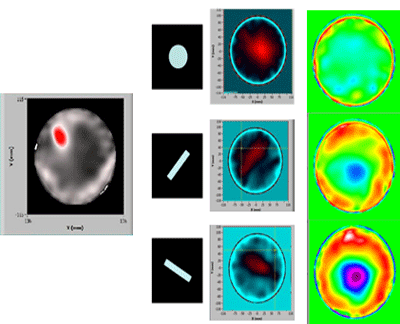Summary
Calorimetry based upon remote sensing of the temperature field in an irradiated volume would offer distinct advantages for the dosimetry of nonstandard beams used routinely for cancer treatment and, more generally, for spatial mapping of dose distributions. This project is exploring the feasibility of using ultrasound and laser light to image dose fields within matter.
Description

Ultrasound and laser interferometry, widely used for nondestructive testing and remote sensing applications, are being used here to measure dose distributions in irradiated water phantoms by taking advantage of temperature dependence in the speed of sound and optical index of refraction of water—absorbed dose heats the water, thus temperature changes can be used to determine absorbed dose.
The ultrasound project began with the development of a single-transducer, pulse-echo system employing phase-sensitive detection, which was able to resolve sub-milliKelvin temperature changes in water irradiated by a therapy-level Co-60 beam. Subsequently, a circular transducer array was developed for tomographic imaging of temperature distributions in water under high-dose irradiation from a Van de Graaff accelerator and therapy-level radiation from a Clinac 2100C medical accelerator, both at NIST. Current efforts are focused on improving data-acquisition and image-processing rates.
The laser interferometry project was started after initial estimates and measurements demonstrated that it could be an order of magnitude more sensitive than ultrasound for detecting radiation-induced temperature changes in water. A simple Michelson setup was then used to measure temperature rise in water subjected to multiple 10-minute, 4 Gy/min exposures to 12 MeV electron beams. Current efforts are focused on improving signal stability and noise reduction with modifications to the interferometer setup and image processing algorithms.

